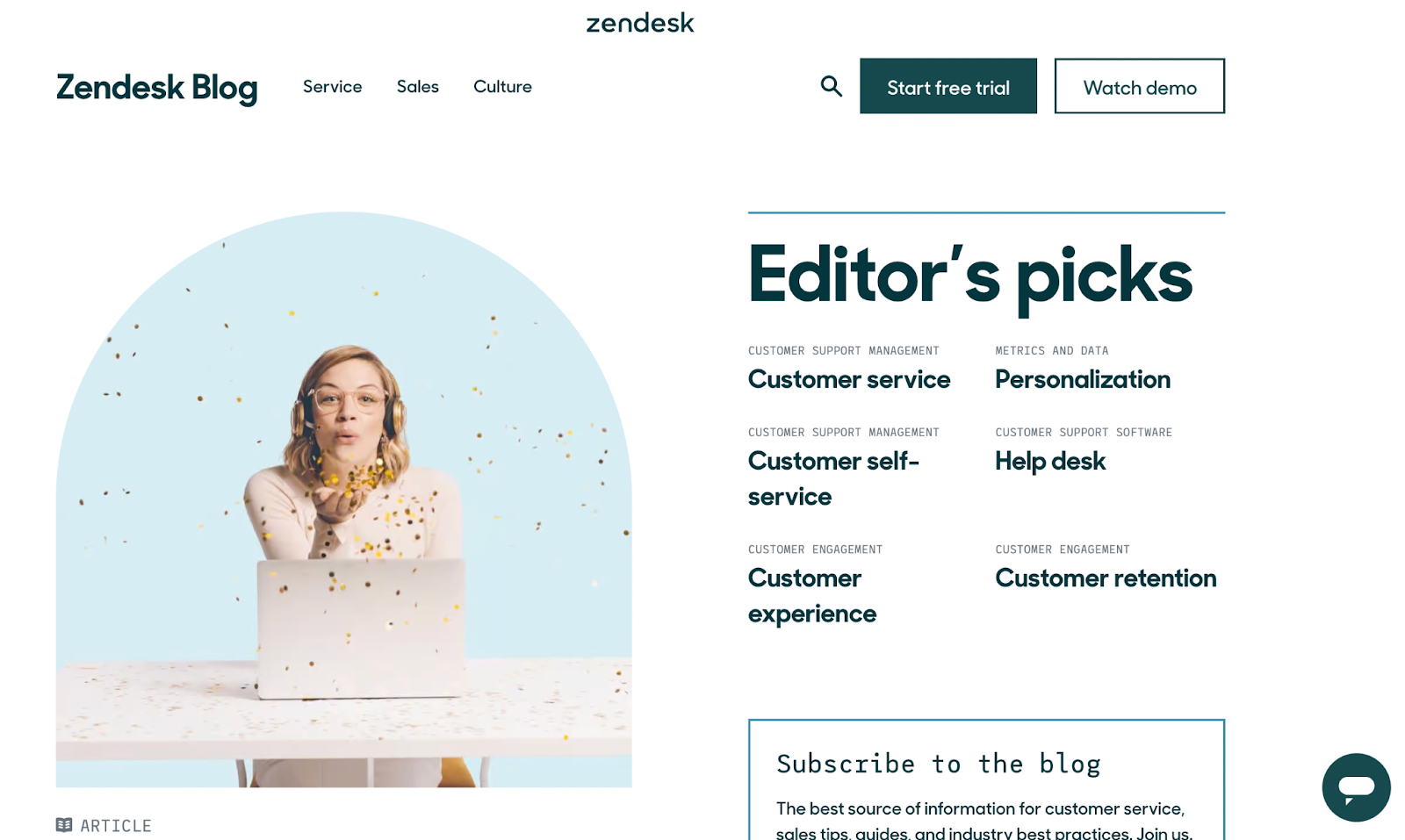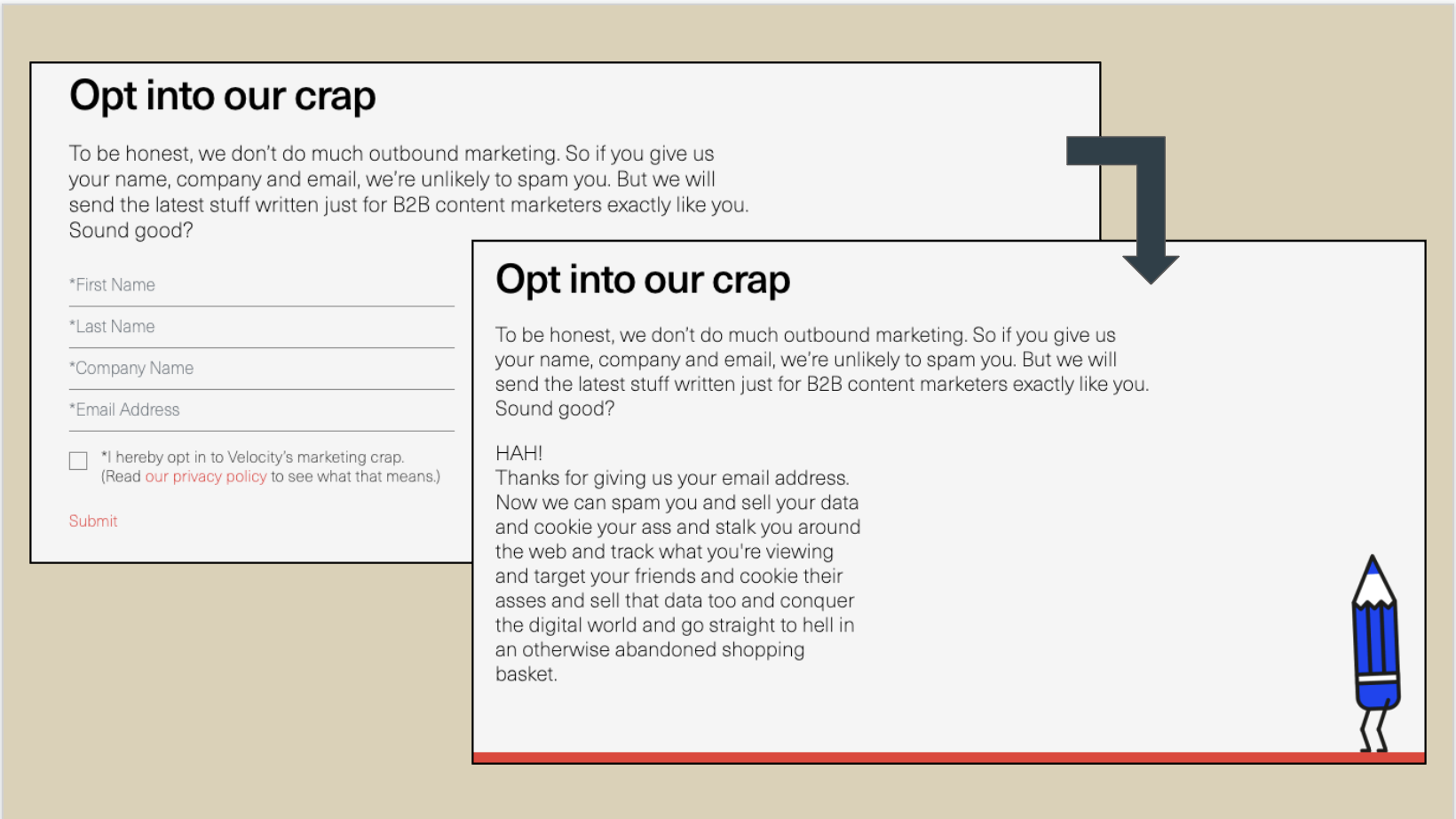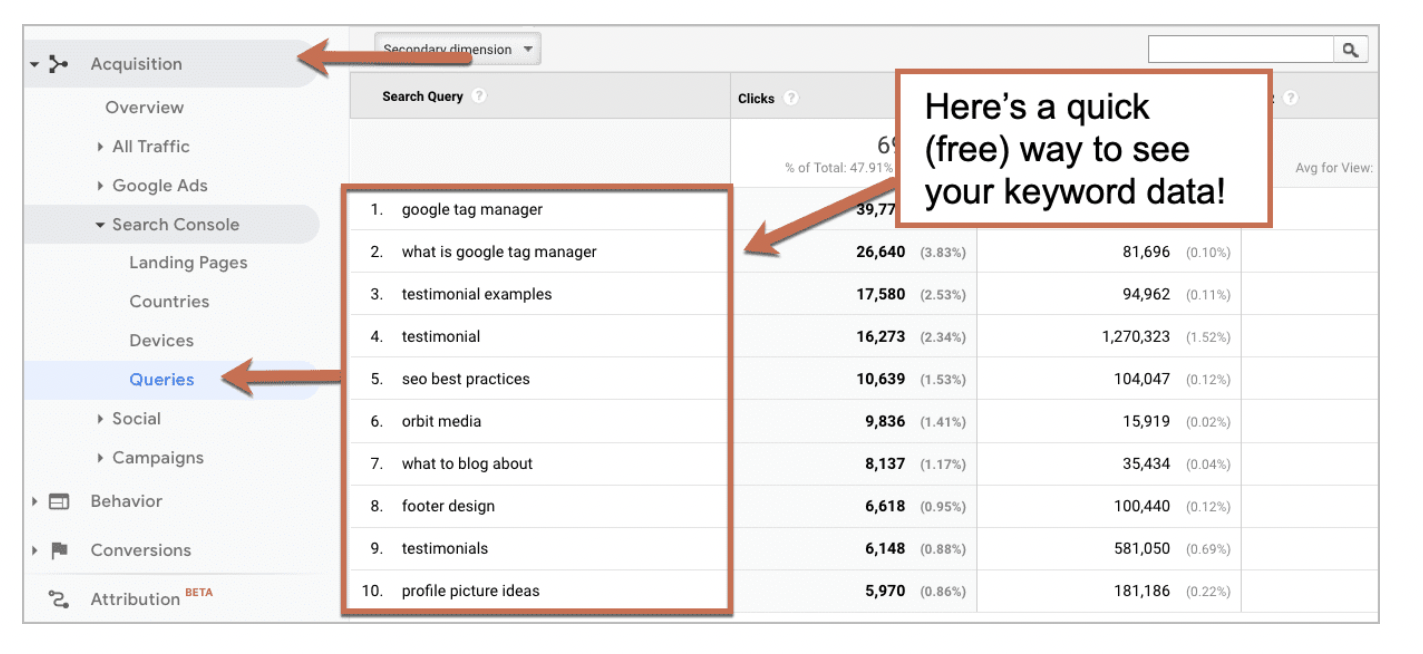The Best B2B Blogs To Nourish Your Writer Brain
I’ve got a confession to make. I’m a bit of a digital hoarder. I’ve got a “swipe file” folder on my desktop that is perpetually bursting at the seams with screenshots of copy that made me giggle or think, “Damn, I wish I wrote that.” While this habit is awful for the level of disc space on my MacBook, it’s been invaluable to me as a writer.
Why? It’s because I strongly believe that nourishing oneself with a rich information diet is the best way produce high quality creative output. If you’re just consuming the same stale old whitepapers as everyone else … guess what? You’re probably going to end up producing the same stale old whitepapers as everyone else. But if you fill your plate with delightful stories? Then bits and pieces of ideas will do a fancy little waltz in your subconscious and recombine into original variations better than anything you could have imagined.
That’s why I’m opening up my swipe file and sharing my personal favorite B2B blogs and content pieces. Among them, you’ll find a B2B satire news site, guided meditations for overworked CSMs, and a fake grunge band cleverly devised by a software brand. Give these exceptional content pieces a gander, and you may be surprised by how they end up influencing your writing.
What you’ll find in this article
Best B2B blogs by tech companies
Best B2B blogs for content marketers
Best non-B2B publications
Best B2B blogs by tech companies
Typeform
People really love Typeform’s blog. So much so that its creator Paul Campillo regularly gets recognized at conferences. He’s sometimes even greeted with hugs and requests for selfies. “This woman came up to me at a conference and said, ‘I'm a data scientist, but I love your marketing,’” he recalls. “The reactions people have to [the blog] are pure emotion. It transcends the product, which is good because your product will change, but those feelings won’t.”
Technology Imitates Art might be one of the team’s best pieces. Half blog post and half chatbot experience, it’s a quippy, fast-paced look at the history of conversational interfaces. It’s also incredibly thoughtful, well-researched, and peppered with fun multimedia gems like movie clips and comic strips. It’s also a clever example of meta-marketing, where Typeform is using its own chatbot technology to tell a compelling story.
Content speaks. In this case, literally.
Start with these standout pieces:
Elements to emulate: Experiment with innovative formats. Have a crystal-clear blog mission. Use meta-marketing to ‘show and not tell.’
2. Catalyst
How do you go viral in B2B? Well, The Unicornian got about as close as I’ve seen. Modeled after The Onion, The Unicornian is the tech industry’s own satire publication. It was launched as a microsite by the content team at Catalyst, a customer success platform.
You heard it here first.
The team also produces wonderful content on their main blog. They recently launched a mental health initiative, where they took the trending topic of mental health, and tailored it very specifically to their target buyers: customer success managers and leaders. The result is a delightful microsite with a research report about the state of wellbeing in customer success, templates for reflections, and even guided meditations specifically for CSMs.
Start with these standout pieces:
Elements to emulate: Invest in branding even though it’s hard to quantify results—brand becomes demand. Don’t shy away from humor. Tailor trending topics to your buyer.
3. Intercom
Why does so much B2B content fail to resonate? It’s because of “novices posing as experts,” according to Jimmy Daly, Co-Founder and CEO of Superpath. “Most content creators have decent writing skills, but little [subject matter expertise]. This is a formula for noise.”
How do you get heard amongst all the competing voices vying for attention? Intercom, whose content marketing operation is nearly as well-known as its product, sets itself apart by encouraging their internal experts to write blogs. When new employees are onboarded, every single one is told they’re required to contribute to the blog. To date, 204 employees have authored blog posts for Intercom.
“I think it would be quite disingenuous if I sat down and started writing an article about the future of design,” says Geoffrey Keating, the former Senior Editor at Intercom. “I could write it, but I’d likely miss the subtleties and nuance a designer will have from years [on the job.] The best writing comes from lived experience and that article is going to be much more impactful if it actually comes from a designer.”
This strategy comes with significant challenges bridging the gap between subject matter expert (SME) and writing expert, but the marked difference in quality is unmistakable and gives Intercom an edge in the highly competitive messaging platform space. (Read more about how Geoffrey overcame these obstacles to build a well-oiled content machine.)
Start with these standout pieces:
Elements to emulate: Elevate the voices of experts from all departments. Think of content marketers as journalists who hunt for—rather than invent—stories. Don’t pretend to be an SME; collaborate with those who are.
4. Zendesk
As soon as you land on Zendesk’s blog, you immediately sense it’s going to be worth your while.
A welcoming blog page experience. And there’s confetti!
While so many marketers organize their blog pages chronologically, or by content format, Zendesk’s is organized by topic pillars that their customers care about. Instead of assuming the marketer’s perspective—where the order in which pieces were written is significant—they assume the customer’s perspective where topics are the most important organizing principle. They also highlight a curated bunch of content to pin at the top—a clever way to surface top-performing pieces that would get buried if organized chronologically.
One of my personal favorite content marketing pieces they’ve produced is Zendesk Alternative. It’s a microsite meant to capture search traffic from the keyword “zendesk alternative”—that is, people searching for their competitors’ products. But instead of competitor products, searchers will find the spoof website of a 90s Seattle grunge, Nirvana-esque band called “Zendesk Alternative.”
Smells like meme spirit 🤘
Not only is it an ingenious way to capture traffic from folks looking for alternatives and redirecting to Zendesk itself, but it’s also hilarious. I love imagining the meeting or Slack thread where someone threw out this idea as a joke and somehow … they invested the resources to make it happen. You gotta respect marketers who commit to the bit.
Start with these standout pieces:
Elements to emulate: Remind yourself to assume your customer’s point of view. Organize your blog thematically and not chronologically. Commit to the bit!
5. Evernote
My favorite thing about the Evernote blog is that it often references actual books instead of questionable Forbes articles, like many B2B blogs are guilty of. (No shade, Forbes. Okay, actually maybe some shade.) For example, this blog post breaks down key concepts from Atomic Habits and this blog post references The Power of Habit.
Books, remember those things? It's like someone printed a website…
Their content is thoughtful and well-researched, covering topics like productivity, creativity, and mental health. They do a good job of weaving in product feature mentions that never feel shoe-horned or intrusive, like in “The 4 Ds of Habit Creation,” a piece about forming better habits that end on some suggestions that involve product features.
The Evernote blog also does a great job of speaking to multiple personas at once. As a note-taking app, you can imagine how broad their use cases and buyer personas are. “12 Powerful Stress-Busting Tips You Need to Know” is an article that cleverly uses interactivity to let readers self-segment and get tips that apply to them—whether they use Evernote for their career, their health, or their finances. The use of GIFs also creates visual interest and gives the piece momentum.
Start with these standout pieces:
Elements to emulate: Reference books that make your audience feel smart. Weave in product mentions in natural places. Find ways to speak to multiple personas with single assets.
Best B2B blogs for content marketers
Velocity Partners
Don’t let the expletives and playful tone fool you—the Velocity Partners blog is incisive, witty, brilliant stuff. Co-founders Stan Woods and Doug Kessler have over 40 years of experience in B2B marketing and copywriting, and the depth of their insight is simply unparalleled.
Delightful, playful copy like this, it’s just …. *chef’s kiss*
They’re good at systematizing complex concepts, like in Eight strategic story arcs that shape almost every B2B narrative. They’re among the few writers I would genuinely call “thought leaders,” if you’ll excuse the horrendously overused term. I love that they touch on the mental, emotional, and cognitive aspects of content creation as much as the mechanics. I’ll often find myself eight tabs deep in their stuff before I realize an hour has passed.
Start with these standout pieces:
Eight strategic story arcs that shape almost every B2B narrative
Why marketers should kill more content—the power of ruthlessness
Elements to emulate: Develop your unique voice. (And if your voice is sarcastic and irreverent—that’s a-okay.) Steal inspiration from a wide variety of non-B2B sources—from 17th-century explorers to Simpsons episodes.
2. Animalz
Animalz’s blog deserves praise because it spares no details. Too many B2B blogs dance around with a bunch of vague advice like, “Tell stories,” and “Consider your objectives.” Animalz produces deeply considered strategic frameworks, illustrated with lots of real stories and examples.
They’re also excellent teachers—often coining new concepts with catchy names or helpful visuals. Sometimes their graphics are so dead simple—like a Venn diagram or a quadrant—but they really help ideas stick. I first read their blog post about content creation lanes more than four years ago and I still see that visual in my head every time I’m in a meeting and I’m about to pitch a cross-cut strategy.
A simple but effective visual that sticks.
Start with these standout pieces:
Elements to emulate: Be hyper-specific and generous with real examples. Use more visuals. Don’t concern yourself with publishing frequency nearly as much as with quality.
3. Orbit Media
If you’re an analytics-focused marketer, this blog is a veritable treasure trove of useful information. Orbit Media’s blog first came on my radar after seeing its founder Andy Crestodina speak at a conference in Toronto and scribbling notes so fast my hand was cramping. (Yes, I’m old school like that and write notes by hand at conferences—studies show info sticks better that way.)
While other content marketing advice is frustratingly high-level, Andy comes armed with screenshots. He demystifies complex Google Analytics reports and makes you feel like, “Yeah I probably could handle that.” Instead of balking at the labyrinthine dashboard, he takes you by the hand and connects the hyper-tactical to the strategic. The writing can be a little on the dry side, but the stellar value makes it worthwhile.
Love a good annotated screenshot!
Andy and team are great at producing original data for their content, with their annual blogging survey, now in its seventh edition. This yearly report is an ingenious PR and backlinks strategy, in that original data gets covered in many publications. The distribution strategy is built right into the content itself. And, since the report compiles data through a survey of hundreds of content marketers, it has a built-in audience of folks who will read and share the report. Since they got to be part of its creation, survey participants are often eager content promoters.
Start with these standout pieces:
Ignore at Your Own Risk: 3 Gaps Your Analytics is Trying to Warn You About
13 Analytics Reports You Should be Using (But Probably Aren't)
What Do Website Visitors Want? It's Not What B2B Brands Are Giving Them [New Research]
Elements to emulate: Generously give away your knowledge. (According to Andy, “the most generous marketer wins.”) Annotate screenshots to explain tricky processes. Produce original data.
4. Contently
Nobody cares more about quality writing than journalists. That’s why Contently’s blog, The Content Strategist, packs a powerful punch. It’s spit-out-your-coffee funny at times, and a solid resource for content strategy, storytelling, and measurement. Pieces are sprinkled with literary allusions, historical tidbits, and pop culture references.
Start with these standout pieces:
Elements to emulate: Think like a journalist. Give your blog a brand container. Bring in cultural references that will delight readers.
5. Fenwick
Wait, before you scream, “I’ve been lied to, that’s her company’s blog!”, hear me out. One of the major reasons I ended up joining the team at Fenwick was that I loved the blog. Pieces like “No Good Writing Begins With Google Search” had me emphatically screaming “YES!” at my computer screen long before I ever entertained the idea of joining the team.
The writers on the Fenwick team are among the most talented and thoughtful I’ve ever worked with. Chris Gillespie, Founder and CEO, spent a whole year studying headlines before he wrote “The Hardest Way to Write B2B Headlines is Also the Best.” Carina Rampelt, Contributing Editor, underwent a full process overhaul before she endeavored to write about using Kanban to keep writers organized.
Both articles were part of the Mastery Project series—where the team only releases a handful of articles per year, but each one is packed with battle-tested tips and deep insights that can only come from careful consideration over long periods of time.
Start with these standout pieces:
Elements to emulate: Use a thorough editing process to make your work sparkle. Always be collecting interesting tidbits like an inspiration magpie. Read widely because it’ll inform and improve your work in unexpected ways.
Best non-B2B publications
I’m going to get a little meta here. We’re going to steal from Velocity Partners’ “Let’s Steal From” series, shall we? Some of the best inspiration comes from outside the genre, so we’re going to look at publications outside of B2B that have lessons us marketers can learn from.
1. The New York Times
In addition to unparalleled journalism and insanely prolific output—200 articles per day—the way that The New York Times has adapted to the digital age is remarkable and has many lessons to teach B2B marketers. Because it’s not enough to write the thing, you’ve gotta get eyeballs on them. (And ideally, you want those eyeballs to widen in fascination.)
Their leaked 2014 digitization report is a 97-page PDF full of content marketing gold. When The Times realized that clickbait factory publications like BuzzFeed and Huffington Post were getting more engagement than their award-winning journalism, they knew they had to invest as much in producing engagement as they did in the journalism itself.
They recognized the need to oust the vestiges of “print-centric” traditions, like organizing their app as an exact replica of newspaper sections, and instead crafted a strategy to optimize for engagement. But it wasn’t easy to simply nix “the habits and traditions built over a century and a half of putting out the paper.”
So the team went on “a listening tour of the business side.” They “met with hundreds of employees from around the newsroom [and] interviewed leaders at dozens of news organizations and spent time with readers. [The team] pored over internal analytics, studied competing websites, and read more reports, presentations and articles about changes in digital media than we can count.”
The NYT team really did their homework.
The output of this report included experimenting with new clever digital formats, creating highly shareable content, and drawing on more participation from readers, The Times’ “greatest untapped resource.”
Today The New York Times stands out as a uniquely digital-first publisher, and one that B2B content marketers would be wise to draw inspiration from. Their 30-Day Well Challenge, an interactive mini email course on living a healthy lifestyle, actually inspired two projects for Fenwick clients—Loopio’s RFP Academy and Bessemer Venture Partners’ B2B SaaS Pricing Course. (Check out this article if you’re curious to see behind the scenes of why and how the NYT created the course.)
Start with these standout pieces:
Elements to emulate: Constantly adapt your strategy to changing times. Prioritize engagement as much as quality writing. Build a two-way relationship with readers to cement loyalty to your publication.
2. The Economist
I’m going to level with you—I don't read much of The Economist. (*Shakes fist at paywalls.*) But when the Fenwick team reviewed a previous draft of this article, they insisted it was essential to include.
“I love that they're a 178-year-old, storied publication you'd think would be stodgy, but in reality they often have a lighthearted approach and write with wry wit,” says Chris Gillespie. “I take a lot of inspiration from the way they clearly explain dense and complex topics. They're also brazenly honest and frequently self-critical. I always trust articles are going to take me somewhere good.”
“The Economist shows a near-fanatical attention to detail when it comes to the written word, and I’m here for it,” says Carina Rampelt. “I love that they root their style guide in George Orwell’s essay ‘Politics And The English Language’ and are allergic to clichés.”
The Economist also frequently shares their expertise and philosophy on writing with the public. “Every time they host a writing webinar, you’ll catch me on the stream,” says Carina.
The Fenwick team also holds a special place in their hearts for The Economist's legendary obsession with puns. In fact, the publication employs a full team of interns whose only job is to infuse headlines with puns for The Economist app.
Start with these standout pieces:
Elements to emulate: Have pun with language. Thoughtfully create a style guide—and use it! Avoid clichés like the plague. 😉
3. The Atlantic
The Atlantic has been around since 1857, and impressively, it’s still driving cultural conversations forward. Much like The New York Times, the publication has had to adapt to drastically changing media consumption habits. Their collection of newsletters is a shining example of one of the things they do best: editorial contextualization. The newsletters range from Arthur C. Brooks’ “How To Build A Life,” where he explores happiness and meaning to “One Story to Read Today,” where the editors recommend a single story for folks who are overwhelmed by the news cycle but want to understand the most important issue of the day.
Over time, readers build a relationship with editors who write the newsletters. They don’t just deliver a pile of links. They tell you—often through personal anecdotes—why you should care. It’s a great case study for content marketers who have to craft their own social posts and emails for the blog posts they write. It shows how to “zoom out” and make your pieces shine with a wider context.
The Atlantic also deserves praise for the quality and consistency of their writing. We all have off days, but somehow—probably thanks to the safety net of a world-class team of editors—The Atlantic never seems to. “I do not know how they do it, but every article is just as crisp and erudite,” says Chris.
Start with these standout pieces:
Elements to emulate: Write with razor-sharp precision. Contextualize your writing by telling your readers why they should care. Prioritize crisp and vivid word choice.
4. Harvard Business Review
In a sea of disappointing clickbait, I never feel duped after clicking through to a Harvard Business Review article. Their writers are all experts—from executives to academics and researchers. Their content is incredibly well-researched, but also easy to read and accessible.
I often cite Harvard Business Review in content I write because it’s both accessible and authoritative. Many publications are one or the other. For example, Forbes is easy to read, but not the most reputable or rigorous about quality (they sell placement on their website’s top navigation to companies willing to pay). Academic journals are trustworthy, but nobody’s going to rifle through them to understand your claims. Harvard Business Review upholds a high standard of quality—zero fluff!
They also get an honorable mention for their blog images, which somehow always seamlessly avoid clichés. They are refreshingly non-obvious (a far cry from “Hey we’re writing a blog about brand awareness, let’s use a megaphone illustration.”) Their imagery often uses clever visual metaphors that are beautiful, memorable, and clear. B2B content would be a much more interesting place if it were to follow HBR’s example.
Visual metaphors = 💯
Start with these standout pieces:
Elements to emulate: Visual metaphors drive curiosity and clicks. Aim for a balance between “accessible” and “reputable.” Tap real experts as article authors.
You are what you read
In 1996, Steve Jobs told Wired Magazine, “Creativity is just connecting things. When you ask creative people how they did something, they feel a little guilty because they didn’t really do it, they just saw something. It seemed obvious to them after a while.”
Their creative output flows naturally “because they were able to connect experiences they’d had and synthesize new things,” Jobs continued. “And the reason they were able to do that was that they’d had more experiences or they have thought more about their experiences than other people.”
That’s the power of consuming writing that inspires you. If you can regularly nourish yourself with a rich information diet, with time, you’ll develop your taste and your mental pantry of ingredients you can later draw on. This practice is especially effective if you also analyze why you love these pieces. Either way, you must feed yourself creatively.
So the next time you’re staring at a blank page feeling famished for inspiration, imagine your mom calling you up and asking, “Well, did you eat?!”











